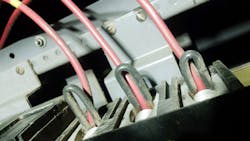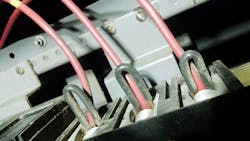What’s Wrong Here? Hint: One, Two, Three Strikes You’re Out!
How well do you know the Code? Think you can spot violations the original installer either ignored or couldn't identify? Here's your chance to moonlight as an electrical inspector and second-guess someone else's work from the safety of your living room or office. It's your turn to identify the violation.
Hint: One, two, three strikes you’re out!
Find the Answer
Gus J. Mininberg of High Voltage Electric Service, Inc. in Albany, N.Y. shared this photo of some wires “tripled-up” under some terminals. According to Mininberg, this is a 400A molded-case circuit breaker he found installed this way. If the terminals are too big for your wire, no problem, just double-up….no wait…make that triple-up the wires to make them fit! Well, at least that’s what this installer apparently did.
This installer also created a Code violation in doing so. Section 110.14(A) states that terminals for more than one conductor must be identified as such. Looking at the size of these terminals, I doubt that they are rated to accommodate such a small wire size. That is probably why the installer needed to jam some extra wires under each terminal. This can result in poor connections, which, in turn, can overheat the wires and terminals, creating a possible fire hazard.
I also question whether or not this wire is properly protected against overcurrent. It seems awfully small for such a large breaker size. Section 240.4 generally requires conductors to be protected in accordance with their ampacities.
About the Author

Russ LeBlanc
Owner
Russ started in the electrical trade as an apprentice in 1985. He worked his way up to become a Journeyman Electrician and then eventually became a Master Electrician and Licensed Construction Supervisor. In 1999 Russ become an Electrical Instructor for The Peterson School of Engineering in Massachusetts where he developed his passion for teaching, and quickly became Department Head of Electrical Instruction. Russ has taught thousands of apprentices, electricians, engineers, inspectors, and other electrical professionals during his career as an instructor. He continues to provide electrical professionals with Electrical Code seminars, Arc-Flash Awareness training seminars and educational material through his LeBlanc Consulting Services in North Reading, MA whose specialty is educating electricians. He has been an active member of the NFPA Electrical Section and has authored hundreds of National Electrical Code proposals and comments which have become Code rules to improve the safety for the electrical industry. Russ is also an IAEI certified Electrical Inspector.
Please visit www.russleblanc.net for more information.

